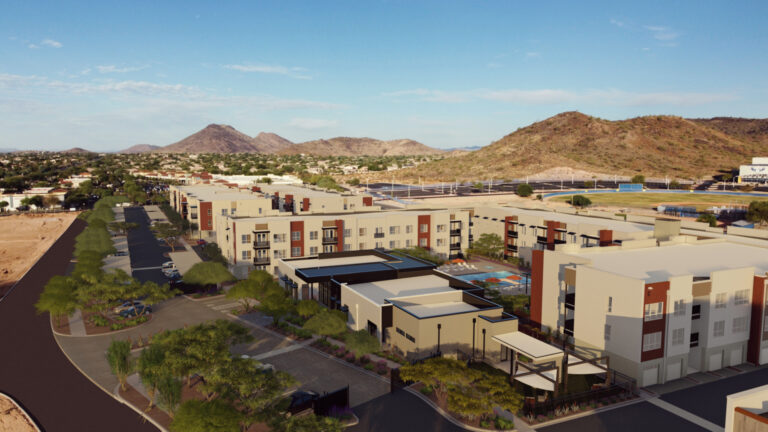By Roland Murphy for AZBEX
Multifamily rents in metro Phoenix fell by 2.9% across all asset classes in August, according to the latest National Multifamily Report from Yardi Matrix.
Nationally, average rent dropped $1 to $1,741 in August, Yardi reports. Rent growth was highest on the East Coast, with New York City increasing 4.8%, and in secondary Midwest markets. The Sun Belt experienced the largest declines, with Austin leading the retreat and seeing YoY rents fall 5.5%. Sun Belt’s performance is largely blamed on the high volume of new supplies coming online.
Month-over-month, rents decreased nationally by 0.1% across all asset classes. Phoenix saw a decrease of nearly 1%.
For Lifestyle-class assets, national rents dropped 0.2%, while Phoenix decreased 1.0%. Lifestyle rents decreased in 19 of the 30 markets Yardi tracks.
Phoenix also saw decreases in the Renter-by-Necessity category in August, which also fell nearly 1.0%. Because of pressure in the Lifestyle category, RBN rents have generally seen better growth performance, with 13 of the 30 metro areas showing gains for the month. Nationally, the August decrease was just 0.1%. Kansas City saw the greatest gains at 1.1%, and Las Vegas led declining markets with a drop of 1.6%.
Yardi reports multifamily sales activity still lingers far below the transaction peaks of 2021 and 2022 and is currently flat for the year. With the market expecting a decrease in interest rates from the Federal Reserve, however, optimism has increased. Yardi also reports there is still a great deal of multifamily-directed liquid capital sitting in reserve on the sidelines that can be deployed as market conditions improve.
“Sales have not dropped due to a liquidity shortage, as there is plenty of dry powder targeted at multifamily. Cortland, for example, just closed a $1.5B value-add apartment investment fund,” according to the report. “Instead, the increased cost of debt since mid-2022 has produced a large bid-ask spread between buyers and sellers. Multifamily properties were trading at historic low 4% to 4.5% yields in 2021 and early 2022 when most mortgage rates were in the 3%-4% range. But 4% yields don’t work when mortgage rates are 6%- 7%. Buyers generally avoid negative leverage and sellers held on to properties rather than selling at reduced prices.”
Build-to-Rent Takes a Hit
While the single-family Build-to-Rent sector is probably not losing any of its “new kid on the block” shine, the segment did see a rare drop in August. Advertised rents dropped $7 for the month, settling at $2,164. The decline was led by the Lifestyle asset category, which dipped $9 month-over-month.
The drop in Lifestyle rents may be an early indicator of top-level price fatigue, Yardi says. “While it is too soon to call this a trend after one month, the dent in Lifestyle (BTR) rents could be a sign that affordability is increasingly stretched. The average Lifestyle (BTR) rent is more than $1,950 in 26 of the top 30 Matrix metros. Performance in the RBN (BTR) sector remains extremely strong, with rents unchanged at $1,823 in August and the occupancy rate 96.6% as of July.”
Year-over-year, BTR rent growth remains slightly positive for the national market. In Phoenix, however—which is widely viewed as the originating market for the segment—rents are down nearly 4%, with occupancy down by between 0.5% and 1%.

